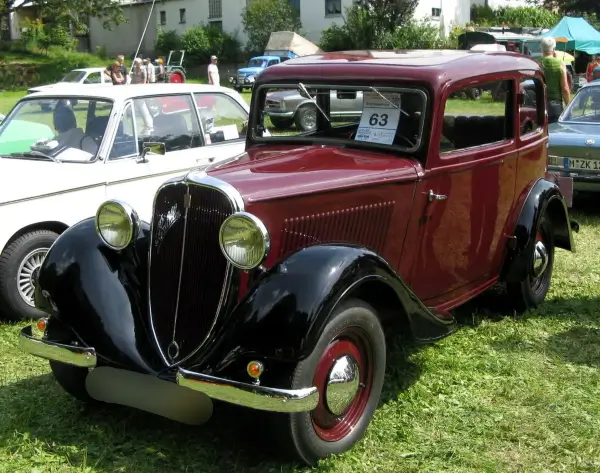NSU Tyres

Classic NSU Tyres
On the following pages, Longstone Classic Tyres give classic tyre fitment recommendations for NSU cars.
01302 711 123
or
Email: sales@longstonetyres.co.uk
NSU History
NSU began in 1873 as a knitting machine maker, founded by Christian Schmidt, a technically savvy entrepreneur, in the Danube town of Riedlingen. In 1880, the company relocated to Neckarsulm. Following a period of tremendous expansion, the firm began to manufacture bicycles, the first of which was a "high wheeler" or "Penny-farthing" marketed as the "Germania" in 1886. By 1892, bicycle manufacture had totally supplanted the production of knitting machines. Around this period, the name NSU became a brand name. The first NSU motorbike debuted in 1901, while the first NSU automobile debuted in 1905.

During WWII, NSU created the Kettenkrad, the NSU HK101, a half-tracked motorcycle powered by an Opel Olympia engine. Das Auto stated in December 1946 that the business had resumed production of bicycles and motorbikes. This was a moment of fresh beginnings for Germany, and in July 1946, a new board was established, led by General Director Walter Egon Niegtsch, who had previously spent 17 years with Opel. NSU motorbike manufacturing resumed in a fully wrecked facility, including prewar designs like the Quick, OSL, and Konsul motorbikes; also, NSU produced the HK101 as an off-road vehicle in a consumer form. In 1949, the NSU Fox, offered in 2-stroke and 4-stroke models, was the first post-war design.
All of these new vehicles featured an innovative pressed steel monocoque frame and a central rear suspension unit. Albert Roder, the principal engineer behind the success storey, made it feasible for NSU to become the world's largest motorcycle manufacturer in 1955. In addition, NSU owns four world speed records: 1951, 1953, 1954, and 1955. Wilhelm Herz became the first man to ride a motorbike faster than 200 mph in August 1956 at the Bonneville Salt Flats in Utah.
NSU re-entered the vehicle market in 1957 with the Prinz, a compact car powered by a doubled NSU Max engine, a two-cylinder 600 cc engine. The engine was air-cooled and produced 20 horsepower. Motorcycle manufacture lasted until 1968. The Quick 50 was NSU's final production motorbike. NSU introduced the Wankelspider, the world's first Wankel engined automobile, in 1964. During the project's development, NSU created the Sport Prinz, which had a 129 horsepower 995 cc 2-rotor engine. In the same year, the Prinz 1000 and variants such as the TT and TT/S were introduced. The Type 110 (later renamed 1200SC) was introduced in 1965 as a larger-bodied family automobile. The air-cooled OHC four-cylinder engine was shared by the last NSU automobiles with a traditional four-stroke engine.

Also in 1964, NSU collaborated with Citroen to develop the Wankel engine through the Comotor division, resulting in the unsuccessful 1973 Citroen GS Birotor production vehicle. The four-door NSU Ro 80 was introduced to the public in 1967. It weighed 1,200 kg, featuring disc brakes, independent suspension, and front-wheel-drive using a three-speed Fichtel & Sachs Saxomatic gearbox. It quickly won multiple design accolades, including "car of the year 1967" and drivers praised its performance. With the noteworthy exception of BMW, virtually all of the world's major automobile manufacturers obtained licences from NSU to develop and manufacture the rotary engine.
Despite much praise, sales of the Ro 80 were poor. The transmission had several problems, and the engine experienced frequent breakdowns before they had covered meaningful miles. Aside from Mazda, competitors resisted taking the lead in developing and marketing the Wankel technology, and the anticipated revenue from those royalty negotiations did not materialise. The construction of the motor was extremely costly for the little company. Problems with the engine rotor's apex seals severely harmed the brand's image among consumers. In 1969, Volkswagenwerk AG purchased NSU and combined it with Auto Union, the proprietors of the Audi brand, which Volkswagen had bought five years previously.
The new business, Audi NSU Auto Union AG, effectively ended the NSU marque, with all future manufacturing under the Audi logo (although retaining the four interlocking circles of Auto Union). The new combine's management was initially located at the Neckarsulm factory, but when the tiny rear-engined NSU models (Prinz 4, 1000, and 1200) were taken out of production in 1973, the Ro 80 was the only car still in production with the NSU logo. Audi never used the brand name NSU again after the last Ro 80 was sold in April 1977. The corporate name was abbreviated to Audi AG in 1985, and management returned to Audi's headquarters in Ingolstadt.
NSU is well known today as the first license holder and one of just four automotive firms to sell automobiles powered by rotary "Wankel engines" The contemporary Wankel engine with an inner rotor was created by NSU. After the Mazda Cosmo, the NSU Ro 80 was the second mass-produced two-rotor Wankel-powered car. NSU's last automobile with a traditional configuration (front-engine, front-wheel-drive, water-cooled) was the NSU K70.
